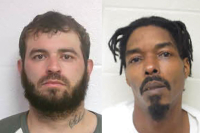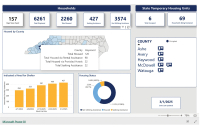Not such a safe place
The Pesthouse by Jim Crace. Nan A. Talese, 2007. 255 pages
“Let’s drop the big one and see what happens.”
This refrain from Randy Newman’s song “Political Science” could serve as the tagline for the whole realm of apocalyptic fiction.
Apocalyptic literature is a new genre in letters and film, new since World War II and the dropping of atomic bombs on Japan. For the last 50 years novelists and screen writers have looked at the possibility of some sort of world-transforming catastrophe in novels ranging from Alas Babylon, On The Beach, and A Canticle for Leibowitz, to The Stand to the Left Behind series and The Road. Filmmakers have also given us views of post apocalyptic life in “Mad Max,” “Dr. Strangelove,” “The Day After,” “Independence Day,” “Planet of the Apes,” and a score of other movies in which the theme is the impending doom of the human race.
A recent addition to this fictional subgroup is Jim Crace’s The Pesthouse (ISBN 978-0-385-52075-1, $24.95). In this novel a once-prosperous America has collapsed into anarchy and a near-medieval existence. Families seeking an escape from the pestilent, toxic land and from roaming outlaw murders try desperately to make their way east to book passage on a ship to Europe.
Among these pilgrims are Franklin Lopez and his brother, Jackson. With his knee inflamed from hiking, Franklin encourages his brother to go on without him and then to return with news and assistance. While Franklin is recuperating, he meets Margaret, who has caught one of the infections plaguing the land. Franklin helps Margaret regain her health, and the rest of the novel is an account of their adventures together. When a particularly vicious band of slave traders and murderers seize Franklin, Margaret and Bella — a child for whom Margaret has assumed responsibility — give up their freedom for the food and security provided by the Ark, a religious community with strange beliefs — all iron is banned as evil, and the leaders of the community don’t use their hands because hands commit sins. As a slave, Franklin suffers many privations, but eventually reunites with Margaret when the bandits attack the Ark. The remainder of the novel is an account of their wanderings and their fight for survival.
Related Items
Croce, who is English, keeps his story moving while at the same time giving us solid characters. He is particularly good at describing the landscape with its undulating terrain and its terrible desolation, and then showing how that topography affects Margaret, Franklin, and Bella, all of whom are on foot for much of the story. Margaret and Franklin themselves also keep us interested in the story. Resourceful and strong, they face the dangers surrounding them with great courage and live with hope in a desolate world.
These stories of doom and disaster apparently attract large audiences. Something deep within human consciousness, at least in the Western world, is attracted by the idea of wholesale slaughter, the breakup of society, the end of formal law. Perhaps our fascination with the destruction of the world has to do with our perception of the world as a technological enigma, even a nightmare of machines and computers, whereas a world arising out of ashes would necessarily be simpler. Perhaps many readers never stop to consider that we would more likely be among the tens of millions of dead than among the survivors. Perhaps we have reached a place in our history where our death wish is running neck and neck with our will to live.
The Y2K non-catastrophe offers real insights into the popularity of these novels and films. Once the momentous New Year’s Eve passed, once the computers failed to crash and cast us into chaos and darkness, nearly everyone breathed a sigh of relief. Those who didn’t stockpile food and ammunition to face the coming night smiled knowingly at neighbors who had transformed their garages into mini Wal-Mart’s. With only a few glitches, the country lurched forward into the new millennium, and we put the possibility of the great catastrophe behind us and soon forgot about it.
Mingled with this collective sigh of relief, however, there was, I think, a mild disappointment among many people that we had averted a major catastrophe. After so much ballyhoo and buildup, the fact that Y2K ended with T.S. Eliot’s whimper instead of a bang left us as disappointed as a kid after a bad prom night. We felt relief that the crisis, invented or real, was over, yet at the back of many minds was the niggling thought: how would we have behaved in the face of the collapse of civilization? Suppose we had experienced a massive shutdown of computers, electrical utilities, airlines, law and order? What would we have done without televisions, radios, cell phones, and computers? Would we be leading rioters through the dark streets? Would we be shooting at the rioters? Would we be holed up in our homes with six months supply of baked beans and toilet paper or roaming the neighborhood with grand-dad’s old .22, fighting like rats for food?
Unlike Y2K, Hurricane Katrina provided a reflecting pool for human behavior, for all sorts of manifestations of the human soul. Katrina produced real heroes and cads, real saviors and killers. Some people made great sacrifices for total strangers; others beat and robbed the strangers with whom they met in those chaotic days. Surely a few of the “good guys,“ as Cormac McCarthy calls them in The Road, learned in part how to behave like good guys from apocalyptic literature. Some Americans may be willing to drop the big one and see what happens. Most Americans, however, surely would see themselves in such a scenario as being the good guys, ready to step into any situation and support the right, and push away the wrong.
That’s what I believe. If push ever comes to shove, I pray I’m on the right side, the side that upholds the ideals of human decency, no matter what sacrifices those ideals require.









